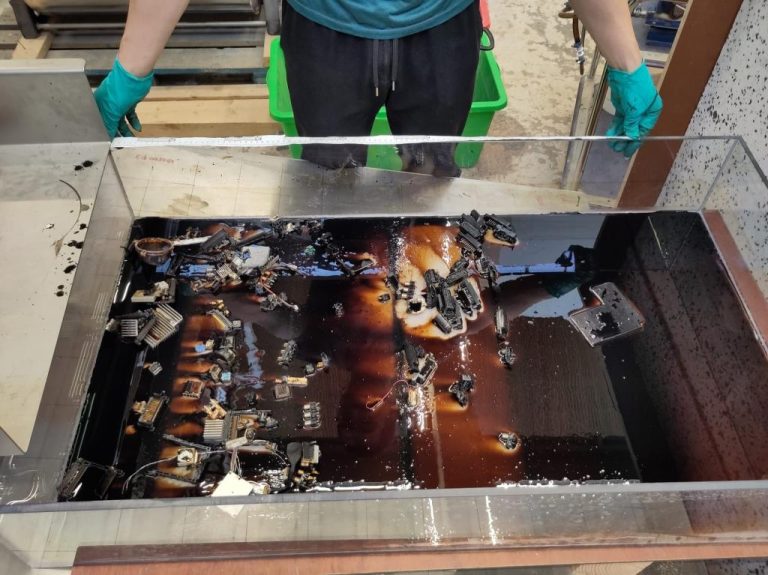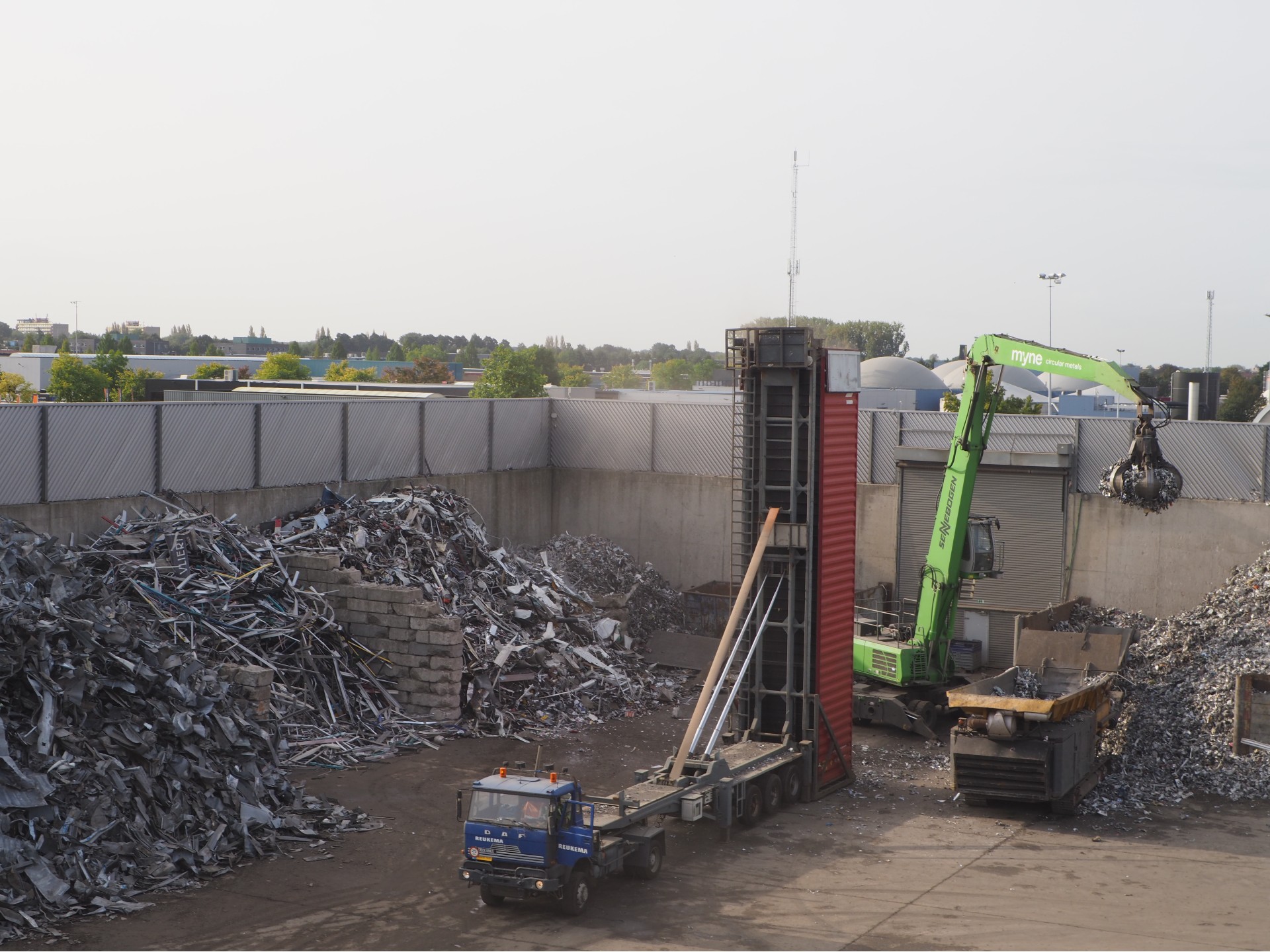Europe is dependent on imported metals for its electrical products. Peter Rem’s group is working on technologies in an EU programme to give waste value.
wordt vervangen
There are crates full of circuit boards waiting for processing at Civil Engineering’s recycling lab. They come from radios, televisions, amplifiers, telephones and computers. Doctoral candidate Max van Beek has become a real expert. The first circuit boards were made of paper and were beige in colour, he explains. Modern circuit boards are made of fibreglass and are green. Components like resistors, capacitors and transistors are becoming ever smaller over time while chips, in contrast, are becoming ever more abundant and complicated.
Many of the components contain small amounts of rare and precious metals such as gold, silver and palladium. Can they be extracted as is desirable in the circular economy? Recycling expert Prof. Peter Rem (Faculty Civil Engineering and Geosciences) believes so. “Extracting rare metals does not pay if the concentrations are low, but it does if they are high. I think European electronic waste contains enough materials after separation for one or two recycling plants.”
What is the status of the amount of electric and electronic equipment and the collection of them in Europe? These are known as electric & electronic equipment (EEE) and waste electric & electronic equipment (WEEE). The annual quantity of equipment with a plug or battery (EEE) rose from 7.6 million tonnes in 2012 to 12.4 million tonnes in 2020, reports Eurostat, the European bureau for statistics. And no wonder as almost all products these days contain electronics or electric engines. The amount of collected WEEE rose from three to 4.7 million tonnes a year (10.5 kilograms per European), thereby remaining a little behind purchase in terms of percentage.

The European Union hopes to collect more electrical and electronic waste. In 2016 the target was to collect 45% of the weight of what had entered the market in the three previous years. From 2019, that figure was 65%. In reality, in 2020 the collected average in Europe was 45% (the target of four years prior to that). The conclusion is thus that the collection of WEEE in Europe could be improved.

Extraction
But what then? What should be done with that collected waste? Ten thousand tonnes of WEEE every year sounds a lot, says recycling professor Peter Rem, but it is only 1% of the million tonnes of bottom ash that waste incinerators in Europe produce every year. Bottom ash is the material that remains behind after the incineration of waste in a waste-to-energy plant. That tiny percentage means that the concentration of valuable metals is much too low to extract from the bottom ash. Worldwide, five times as much plug and battery waste, amounting to 50 million tonnes, is discarded every year.
This is the reason that researchers and industry are working on technologies to extract as much value from the ever growing waste stream. Peter Rem’s group is one of 19 partners involved in the Peacoc research group as part of European Horizon2020 that is working on developing unique and environmentally friendly technologies for the efficient extraction of gold, silver and platinum from waste, states the website. The research programme started in 2021 and will run until April 2025.

Max van Beek and Dr Lin Wang use the roller sorting machine to separate components based on smallest size. (Photo: Jos Wassink)
30-40 containers
Doctoral candidate Max van Beek says that he will start with one kilogram of electronic components containing about 10% of precious components. His research is part of the Circular Circuits NWO (Dutch Research Council) programme. Circuit boards with electronics are a small but valuable part of WEEE waste. The weight percentage varies depending on the type of equipment (ranging from heat pumps to laptops) but is about 5%. The TU Delft research is concentrating on this.
The electronic waste in the bucket has either been taken out of equipment by hand and or comes from disassembling circuit board components (‘depopulation’). This waste has gone through a series of separation techniques: sifting, rolling (the components drop between two turning cylinders and are placed according to their thickness); magnetic separation (a permanent plate magnet is placed at an angle and pulls components to a conveyor belt. The more magnetic the components, the further they go); and magnetic density separation (see below). At the end of the process, one kilo has left behind 150 grams of electric and electronic waste, of which 96 grams (64%) are precious components.
The concentration of valuable materials is thus increased by a factor of 6.4. This is important for the further processing with smelters to extract precious metals. Smelters (the closest ones are in Germany, Belgium and Sweden) are rotating, angled cylinders with molten copper in which the waste ends up for recycling. Plastic and the remains of circuit boards are incinerated or float like slags on the liquid copper. Precious metals such as traces of gold, silver and platinum dissolve in the liquid copper, but can be extracted in metal refineries. Smelters involve an expensive and energy intensive process (costs are about EUR 900 per tonne) that are only economically viable if the initial concentration is high enough.
 The MDS machine separates parts by density: heavy metal parts on the left, light plastic on the right. (Photo: Jos Wassink)
The MDS machine separates parts by density: heavy metal parts on the left, light plastic on the right. (Photo: Jos Wassink)
TU Delft technology
The latest and most advanced step in separating electric and electronic waste is the so-called Magnetic Density Separation (MDS). Rem had previously designed this technique to separate plastics with minimum density differences. Post-doc Dr Lin Wang is now adapting the technique for the maximum separation of electronic components and cables.
The container in which the separation is done looks like it contains oil, but this is not the case. The black liquid is water containing suspended magnetic nanoparticles. A strong permanent plate magnet beneath the container exerts a pull force on the liquid that increases the density. This causes the parts that would normally sink in water to float.
The plate magnet is placed at a slant beneath the basin so that the density of the liquid decreases the further away from the magnet it is. The entry point is on the side with the shortest distance to the magnet and the highest density where everything is still suspended. The particles suspended in the solution flow in rows of similar density and land on the bottom at a distance from the entry point that matches the density.
‘They are economical separation techniques’
Wang drains the black liquid and points to where the components have landed. On the left with the highest density are the non-magnetic metals like aluminium cooling fins and computer chips, in the centre the cinch cables and other plastic and metal connectors, and on the right mostly plastic parts. The left part is the most interesting for recovering precious metals.
“They are the most economical separation techniques,” emphasises Rem. The magnets are permanent and some running electric engines are the only parts that use energy. At the moment, MDS is the cornerstone in the sorting and reprocessing process of electrical and electronic waste. At the end of its journey, the contents of the bucket of mixed electronic waste has been separated into 30 to 40 containers.
Businessmodel
At the beginning of November, an industrial MDS machine prototype was/will be brought to the lab. Before this, Wang had to fill and empty the basin for each new load of waste components. The industrial machine will have a conveyor belt below the MDS separation basin. This will mean the continuous outflow of separated components. The prototype is sponsored by MYNE, formerly Reukema, a metal recycling company in Harderwijk.
 MYNE director Martijn van de Poll has a large supply of wiring harnesses from cars to process. (Photo: Jos Wassink)
MYNE director Martijn van de Poll has a large supply of wiring harnesses from cars to process. (Photo: Jos Wassink)
Its Director, Martijn van de Poll, contacted Peter Rem in 2014. At the time, all the electronic waste was being shipped to Asia to be separated there by hand. Van de Poll saw electronic waste as one of the fastest growing waste markets and started looking for ways to be involved. He asked Rem if he and his team could design a separation technology that was cheaper than the hand separation in Asia. This was the start of research into the processing of electrical and electronic waste at TU Delft.
MYNE now buys electronic scrap from the Netherlands, Belgium, Germany and France. The material does not go to Asia anymore. The first MDS machine that was to separate the waste more cheaply than sending it to workers in Asia has now, after 10 years of development, been built and is being tested in Civil Engineering’s recycling lab. The machine is expected to separate 1.5 tonnes an hour.
“A recycling plant should be able to process 30,000 tonnes a year,” estimates TU Delft alumnus Van de Poll, who graduated in Applied Earth Sciences at TU Delft in 2001. “But 50,000 to 100,000 tonnes would be even better to keep the plant economically viable. If you do some calculations, you will need five to 10 MDS separators.”
“If we would buy five machines, it would be because we believe that it is a viable business model,” says Van de Poll, whose MYNE company is also part of Circular Circuits. “There is pressure everywhere. Legislation is underway that will require recycling to include the reuse of raw materials at the design stage. The biggest step now is that the automobile industry and IKEA are working on their CO2 footprint and the traceability of raw materials. This is a huge step forward compared to five years ago.”

Previously, MYNE and TU Delft developed the Xortrer, a 64-robot sorting line for aluminum alloys. (Photo: MYNE)
Do you have a question or comment about this article?
j.w.wassink@tudelft.nl


Comments are closed.